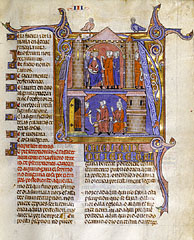Interactive: Click here to see this manuscript page in detail and learn more about the elements of a Gothic manuscript page.
• How is this page like pages from books today? How is it different?
• The elaborate image on this page is called an historiated initial, meaning that the letter contains a scene that tells a story in relation to the text. Can you tell what the letter in this historiated initial is? (It is a letter "A " formed by a slender, arching, elongated dragon.)
• What can you tell about the story in the initial just by examining it?
• What is the setting for the scene?
• How do the people interact with each other? How would you describe their gestures? What do you think they are doing?
• What are some of the colors used to paint the illumination on this page? The gold used on this page is not paint, but gold leaf. Why would someone have had this book made with such an extravagant material?
• Notice that there are birds with human heads decorating the historiated initial. Why do you think the illuminator included these images?
|
In 1247, King James I of Aragon and Catalonia (in present-day Spain) decided to establish a new systematic code of law for his kingdom. He entrusted the task to Vidal de Canellas, bishop of Huesca. The Getty Museum's manuscript, the only known copy of the law code still in existence, is a translation of Vidal de Canellas's Latin text into the vernacular, or regional language, in this case Navarro-Aragonese. The manuscript's scribe was Michael Lupi de Çandiu, who identifies himself in an inscription and who also may have translated the text.
Not only is the text an important historical document, it is also luxuriously illuminated
with hundreds of historiated and decorated initials. This illustrated scene corresponds to a portion of the text devoted to the legal rights of orphans. In the top half of the image, a man in a red robe speaks with the king about the sale of a piece of property. He appears again to the far right, having received the king's judgment. Below, he is shown a third time, approaching a couple and a small child. Because the man's petition to sell the property would deprive the child of his rights to the estate, it is denied.
The two scenes take place in the upper and lower halves of an initial "A." The letter is formed by the arching body of a dragon; the beast's folded wings are seen on the left, while its small doglike head is at the lower right. The two human-headed birds perched on top of the square frame are known as marginalia and add liveliness to the page. |
